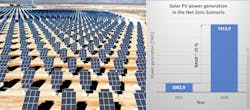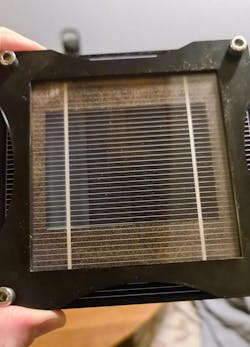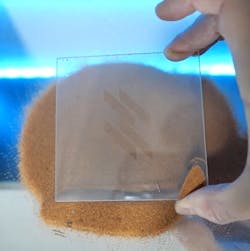Photovoltaics (PV) is becoming the most cost-effective option for new electricity generation in most parts of the world. Much of the installation will be in desert areas where sunlight is abundant, but accumulation of dust on solar modules or mirrors is a major problem that can reduce the performance of PV modules by up to 30% within just one month. It can be solved by fast laser solutions coupled to a biomimicry approach that enables self-cleaning properties—saving billions of liters of water per year.
The world faces major environmental and energy challenges. The global energy sector now accounts for about three-quarters of greenhouse gas emissions and is key to averting the worst effects of climate change—perhaps the greatest challenge facing humanity. Reducing global carbon dioxide (CO2) emissions to net zero by 2050 is consistent with efforts to limit the long-term rise in average global temperatures to 1.5°C.
Renewable energies are considered the backbone of a CO2-neutral industry. Besides wind energy, solar power systems are emerging as the lowest-cost option for new power generation in most parts of the world.
The light-collecting surfaces of solar systems cover areas of more than 3000 km2 worldwide, with PV modules accounting for the majority. Policy support remains a principal driver of solar PV deployment and PV capacity growth, including auctions, feed-in tariffs, net-metering, and contracts for difference.1
In 2021, PV power generation increased by a record 179 TWh (+22%) to about 1000 TWh. After wind energy, it has the second largest absolute generation growth of all renewable technologies in 2021. However, to reach an annual PV generation level of about 7400 TWh in 2030, which is equivalent to the net-zero scenario, a required annual growth rate of about 25% over the 2022-2030 period is mandatory (see Fig. 1).
By 2030, solar energy is expected to account for 33% of global electricity generation and much of it is likely to be installed in arid areas where sunlight is abundant. An often-neglected problem is the contamination of these surfaces, so-called ‘‘soiling,’’ which results in significantly lower energy yields and negates continuous improvements in energy efficiency. Airborne dust concentration is considered the major determinant of soiling, but also bird droppings, biofilms of bacteria, algae, plant debris or pollen, engine exhausts, and industry emissions must be considered.
According to MIT, contamination of PV panels can lead to a sharp energy output drop early in the dust accumulation process, which can easily reach 30% after just one month without cleaning. Estimations show that even a 1% reduction in energy output can result in $200,000 in lost annual revenue for a 150 MW solar installation. So, a 3 to 4% reduction in solar system output would result in a loss of $3.3 billion to $5.5 billion worldwide.2,3 This makes regular cleaning essential for PV installations, especially for those being used for industrial PV generation.
Cleaning can be realized by dry cleaning technologies that are mostly applied in regions with water scarcity, such as desert environments, while wet cleaning technologies are generally preferred due to their increased cleaning efficiency and lower damage potential. It is estimated that approximately 75.71 liters per megawatt-hour are required for cleaning solar panels and reflective surfaces such as mirrors, heliostats, and PV panels.4 Consequently, an annual cleaning volume of 75.71 billion liters of water was consumed in 2021—enough to supply about 138 million people each with 1.5 liters of water per day for one year. Staying in the net-zero scenario, PV water cleaning will scale up to about 560 billion liters of water by 2030, an equivalent to supply about 1 billion people each with 1.5 liters of water per day for one year. This makes it clear that the future of photovoltaics is closely linked to sustainable water resource use.
Until now, no passive anti-soiling technology through surface coatings could eliminate the need for cleaning.
Blueprints for product innovations using lasers
The functionalization of surfaces using laser technologies offers an alternative solution to functional coatings, which are widely used in industry today.
Fusion Bionic, a spinoff from the Fraunhofer Institute for Material and Beam Technology (Fraunhofer IWS; Dresden, Germany) offers an alternative approach to functional surfaces using laser surface texturing. By using the proprietary laser technology of Direct Laser Interference Patterning (DLIP), high-performance surfaces are achievable that offer advanced effects such as a reduced friction, improved contact performance, and many more. In many cases, the surface designs are inspired by natural surfaces such as the lotus leaf or moth eye, which enables novel surface functionalities with self-cleaning or antireflection properties using lasers.
In the past, the commercial use of laser-generated functional surfaces was hardly feasible due to relatively slow laser processing techniques. This has been solved by the DLIP technology, which enables functional surfaces to be produced at speeds on the scale of square meter per minute. Laser texturing has become a strong alternative to functional coatings that often do not meet REACH compliance, or that are highly susceptible to degradation processes under harsh conditions.
Contamination-free PV panels with lotus-like properties
Fusion Bionic has recently developed a proprietary laser process based on its DLIP technology to facilitate bio-inspired micro- and nanostructures to reduce the soiling behavior through dust and dirt on glass surfaces significantly.
Modeled after the lotus leaf effect, it’s possible to demonstrate a selective self-cleaning performance using dirt on glass substrates (see Fig. 2). The laser texturing process used does not require any additional coating and does not affect the glass transparency.The unique feature about the process is that under certain testing conditions, zero water is necessary to clean the contamination from the glass substrate, making the approach a strong alternative to the established passive anti-soiling PV solutions. The cleaning effect was solely possible by tilting the glass surface to angles of ~25°.
The approach was used also with desert sands from the Sahara, Rub' al Khali, Namib, and Kalahari. First tests showed a similar behavior for all desert sands compared to the dust experiments (see Fig. 3), making the approach highly suitable for further application tests under real conditions.Fusion Bionic has begun testing the promising approach with market participants to address commercialization.
As part of this process, a further upscaling of the technology for large-area treatments is in progress. By the end of 2021, Fusion Bionic was able to demonstrate the general feasibility to scale its laser texturing platform to speeds of 3 m2/min. These processing speeds are necessary to meet the demands for large-area treatments on PV panels.
Fusion Bionic’s approach will help tackling global efforts in reducing global CO2 emissions while saving billions of liter of water at the same time.
REFERENCES
1. See www.iea.org/reports/solar-pv.
2. See https://news.mit.edu/2022/solar-panels-dust-magnets-0311.
3. K. Ilse et al., Joule, 3, 2303–2321 (Oct. 16, 2019); https://doi.org/10.1016/j.joule.2019.08.019.

Tim Kunze | CEO, Fusion Bionic
Tim Kunze is the CEO of Fusion Bionic, a spinoff from Fraunhofer IWS (Dresden, Germany), which focuses on the commercialization of laser texturing solutions using direct laser interference patterning for large-area and high-speed laser surface functionalization. He holds a master’s degree in computational science and a Ph.D. in natural science.


